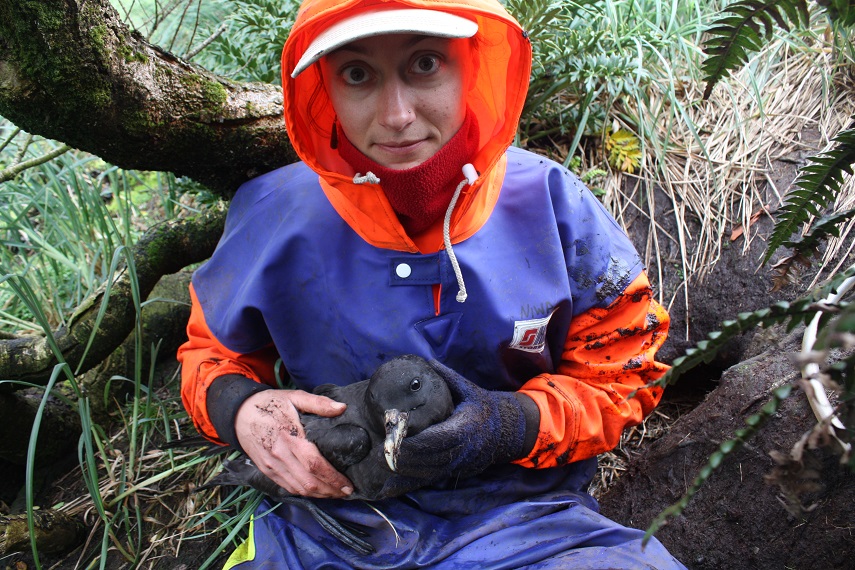Kalinka Rexer-Huber (Department of Zoology, Otago University, Dunedin, New Zealand) has been awarded a PhD for her study of the ACAP-listed White-chinned Petrel Procellaria aequinoctialis following field work conducted on New Zealand’s sub-Antarctic Auckland and Campbell Islands.

Kalinka on Adams Island in the Auckland Islands group, holding a White-chinned Petrel in front of its burrow
The thesis abstract follows:
“Albatrosses and petrels are a group of oceanic seabirds that spend most of their lives at sea. The Southern Ocean, which rings Antarctica in a continuous belt of wind and currents, supports most of the world’s albatrosses and petrels. The conservation status of many oceanic seabirds has deteriorated dramatically over the last two decades, due to mortality from incidental bycatch in fisheries and depredation by introduced mammals at breeding sites. Globally, seabird bycatch is highest in Southern Ocean waters and introduced mammals occur on a third of sub-polar and high-latitude seabird islands.
The seabird species most frequently killed in Southern Hemisphere fisheries bycatch is the white-chinned petrel Procellaria aequinoctialis. Almost three decades after substantial white-chinned petrel mortality in fisheries was first recorded, capture rates remain high despite substantial global efforts to reduce bycatch rates. Population impacts are exacerbated by introduced mammals at some breeding sites, yet some island populations are still virtually unstudied. White-chinned petrels breed on eight subantarctic island groups around the Southern Ocean. Key steps toward targeted conservation are obtaining robust estimates of abundance and at-sea distribution, and defining the scale of genetic conservation units within the species. Population-level questions in these key areas limit the ability to gauge the impact of current threats locally and around the Southern Ocean, and hinder informed conservation, management action and policy development.
This thesis broadly asks at what scale(s) processes affect species distribution, abundance and connectivity in the Southern Ocean ecosystem, with the white-chinned petrel as the focal species. It evaluates status and connectedness of white-chinned petrels breeding on subantarctic islands around the Southern Ocean via three broad approaches:
- Population size estimates for the Auckland Island and Campbell Island breeding populations, the last two island groups lacking estimates of white-chinned petrel numbers (Chapter 2);
- Tracking devices follow the at-sea movements and distribution of 150 white-chinned petrels year-round, from all major breeding islands (Chapter 3); and
- Molecular genetics tests connectedness within the white-chinned petrel metapopulation, using sequences from mitochondrial and nuclear genes as well as genomic data from every island population (Chapter 4).
This thesis provides the first robust population size estimates for white-chinned petrels at the Auckland Island and Campbell Island groups, including 11 islands (Chapter 2). Burrow numbers were sampled widely to capture spatial variability (33–241 randomised sampling sites per island). Estimated burrow numbers were corrected with detection rates and occupancy rates to estimate numbers of breeding birds. The Auckland Island group has an estimated 186,000 (95% CI: 136,000–237,000) white-chinned petrel breeding pairs, and the breeding population of the Campbell group is estimated ~ 22,000 (15,000–29,000) pairs. The New Zealand region supports almost a third of white-chinned petrels globally, substantially more than suspected. Importantly, the estimates establish repeatable population baselines. Tracking data from all major island populations except Campbell Island were analysed together, giving the first metapopulation-scale picture of the at-sea distribution of adult white-chinned petrels (Chapter 3). The movements of 150 adult petrels (9–33 petrels per island group) were tracked for an average of 369 days with light-level geolocation GLS loggers. Quantitative density estimates for white-chinned petrels show key global density hotspots (off South America, New Zealand, and southern Africa). Island population-specific distributions highlight areas used only by adults from a given island population. Island-specific distributions also show spatial segregation between island populations varying across the year to an extent unusual for seabirds, so the implications for resource partitioning are explored (Chapter 3). Using comprehensive sampling from every island population, high-resolution genomic data (60,709 genotyping-by-sequencing loci) was compared with data from widely-used mitochondrial genes (entire cytochrome b gene and the highly variable 1st domain of control region) (Chapter 4). Genomic data revealed genetic structure in white-chinned petrels at very fine scale (among islands) and at broad oceanic scales (between Atlantic and Indian Ocean regions) that was not detected in analyses of single genes. Three ocean-basin scale evolutionarily significant units, ESUs, were identified. There is promise that some island populations are sufficiently unique to link mortality in a specific fishery to a given island (Chapter 4). The results of the thesis are synthesised (Chapter 5) to explore the implications for conservation and the broader biogeographic context.”
In 2014 ACAP made a grant to New Zealand’s National Institute of Water and Atmospheric Research (NIWA) to undertake a population estimate of the Whie-chinned Petrel Procellaria aequinoctialis on Disappointment Island, Auckland Islands. The field work was carried out over the 2014/15 summer by Kalinka Rexer-Huber click here).
With thanks to Kalinka Rexer-Huber, whose PhD is being formally conferred today with her graduation to take place next year in May.
Reference:
Rexer-Huber, K. 2017. White-chinned petrel distribution, abundance and connectivity have circumpolar conservation implications. PhD thesis. Dunedin: University of Otago. 166 pp.
See also:
Rexer-Huber, K., Parker, G.C., Sagar, P. & Thompson, D. 2015. White-chinned Petrel Population Estimate, Disappointment Island (Auckland Islands). Report to the Agreement for [sic] the Conservation of Albatrosses and Petrels. Dunedin: Parker Conservation. 14 pp.
Rexer-Huber, K., Parker, G.C., Sagar, P.M. & Thompson, D.R. 2016. White-chinned petrel population estimate, Disappointment Island (Auckland Islands). Polar Biology 40: 1053-1061.
John Cooper, ACAP Information Officer, 13 December 2017

 English
English  Français
Français  Español
Español